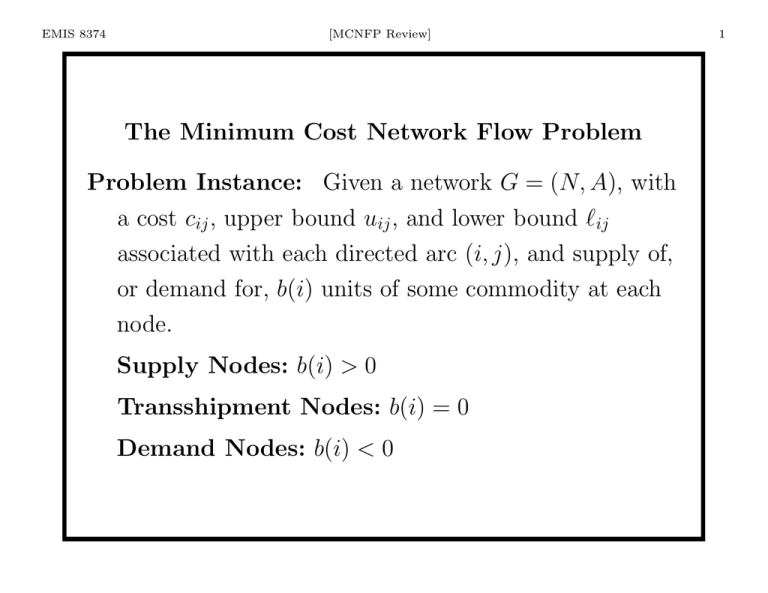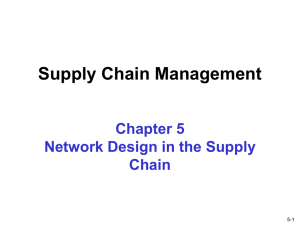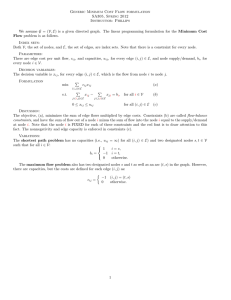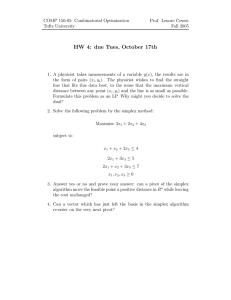The Minimum Cost Network Flow Problem Problem Instance: Given
advertisement

EMIS 8374
[MCNFP Review]
The Minimum Cost Network Flow Problem
Problem Instance: Given a network G = (N, A), with
a cost cij , upper bound uij , and lower bound `ij
associated with each directed arc (i, j), and supply of,
or demand for, b(i) units of some commodity at each
node.
Supply Nodes: b(i) > 0
Transshipment Nodes: b(i) = 0
Demand Nodes: b(i) < 0
1
EMIS 8374
[MCNFP Review]
2
Linear Programming Formulation: The problem is
that of finding a minimum-cost feasible flow:
min
X
subject to
(i,j)∈A
X
cij xij
xij −
{j:(i,j)∈A}
`ij ≤ xij ≤ uij
X
xji = b(i)
∀i ∈ N,
{j:(j,i)∈A}
∀(i, j) ∈ A
Note the problem is not feasible unless the supplies
P
and demands are balanced (i.e., i∈N b(i) = 0).
EMIS 8374
[MCNFP Review]
The Circulation Problem: A MCNFP where b(i) = 0
for all nodes.
The Transportation Problem: A MCNFP where
• A bipartite network where N = N1 ∪ N2
(N1 ∩ N2 = ∅)
• N1 are supply nodes and N2 are demand nodes
• i ∈ N1 and j ∈ N2 for all (i, j) ∈ A
The Assignment Problem: A Transportation Problem
where
• |N1 | = |N2 |
• b(i) = +1 for all i ∈ N1 and b(j) = −1 for all j ∈ N2
3
EMIS 8374
[MCNFP Review]
The Shortest Path Problem: defined on a network
with arc costs, but no capacity limits. The objective is
to find a path from node s, the source, to node t, the
sink, that minimizes the sum of the arc costs along the
path.
To formulate as MCNFP:
• s is a suppy node with b(s) = 1.
• t is a demand node with b(t) = −1.
• All other nodes (N \ {s, t}) are transshipment nodes.
• `ij = 0 and uij = 1 for all arcs.
4
EMIS 8374
[MCNFP Review]
5
LP Formulation of the Shortest Path Problem
min
X
subject to
(i,j)∈A
X
cij xij
{j:(s,j)∈A}
X
{j:(i,j)∈A}
X
xsj −
X
xij −
{j:(j,s)∈A}
X
xtj −
{j:(j,i)∈A}
X
{j:(t,j)∈A}
0 ≤ xij ≤ 1
xjs = 1,
xji = 0 ∀i ∈ N \ {s, t},
xjt = −1,
{j:(j,t)∈A}
∀(i, j) ∈ A.
EMIS 8374
[MCNFP Review]
The Maximum Flow Problem: defined on a directed
network with capacities, and no costs. In addition two
nodes are specified, a source node, s, and sink node, t.
The objective is the find the maximum possible flow
between the source and sink while satisfying the arc
capacities.
6
EMIS 8374
[MCNFP Review]
7
LP Formulation of the Maximum Flow Problem
max
subject to
v
X
{j:(s,j)∈A}
X
{j:(i,j)∈A}
X
xsj −
X
xij −
{j:(j,s)∈A}
X
xtj −
{j:(j,i)∈A}
X
{j:(t,j)∈A}
`ij ≤ xij ≤ uij
xjs = v,
xji = 0 ∀i ∈ N \ {s, t},
xjt = −v,
{j:(j,t)∈A}
∀(i, j) ∈ A.
The scalar variable v is referred to as the value of the
flow vector x = {xij }.
EMIS 8374
[MCNFP Review]
8
The Max Flow Problem Formulated as MCNFP
Convert the problem to an equivalent minimum cost
circulation problem as follows:
• Let cij = 0 for all (i, j) ∈ A.
• Let b(i) = 0 for all i ∈ N .
• Add an arc from s to t with cost cst = −1.
min −xts
s.t.
X
xij −
{j:(i,j)∈A}
`ij ≤ xij ≤ uij
X
xji = 0 ∀i ∈ N,
{j:(j,i)∈A}
∀(i, j) ∈ A.
EMIS 8374
[MCNFP Review]
The Texas Confectionery Company (TCC) produces
three types of candy bars at two different plants.
• Houston plant produces Rice Krunchy and Aggie bars.
• Austin plant produces Aggie Bars and Longhorn Bars.
• There are 160 hours of production time available per
month at each plant.
9
EMIS 8374
[MCNFP Review]
Product
Production Cost
10
Product Time
Demand
Name
Houston
Austin
(Minutes)
(Units)
Rice Krunchy Bar
$0.04
-
30
200
Aggie Bar
$0.05
$0.06
20
280
Longhorn Bar
-
$0.06
15
320
(a) Formulate a MCNFP that TCC can solve to
determine how to minimize the cost of meeting the
demand for its products. Briefly describe what the
elements (nodes, arcs, capacities, etc.) of your network
model represent.
Hint: How many hours of production time are required
to meet the demand for each type of candy bar?
EMIS 8374
[MCNFP Review]
(b) Suppose that TCC wants to plan two months in
advance and believes that it will need 240 Rice Krunchy
Bars, 360 Aggie Bars and 480 Longhorn bars at the end
of next month. If there is time left over in the current
month (after the production for this month’s demand is
finished), then some of these bars can be manufactured
this month and held in inventory until they are needed.
Extend your MCNFP from part (a) to minimize TCC’s
cost for meeting the demand for its products over the
next two months.
14
EMIS 8374
[MCNFP Review]
(c) Candy bars that are stored in inventory must be kept
in a special storage facility so that they do not become
stale. How would you extend your MCNFP from part (b)
to account for inventory holding costs of $0.02 for each
Rice Krunchy Bar, $0.01 for each Aggie bar and $0.05 for
each Longhorn bar?
19





